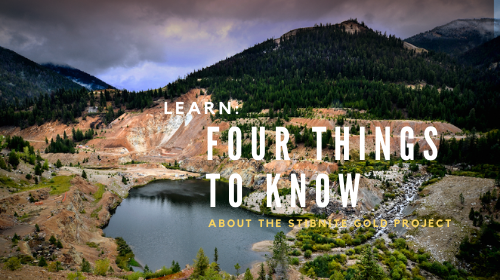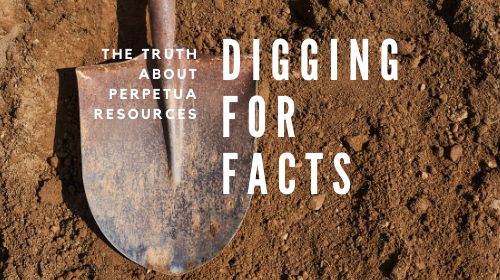↓ Who is Perpetua Resources?
We are a modern mining company that believes mining and the environment can go hand in hand. We are currently working to permit a mining project near Yellow Pine, Idaho that can benefit the economy, the community and the environment all at the same time. You can learn more about our plans here.
Read more here:
IS PERPETUA RESOURCES (FORMALLY MIDAS GOLD) REALLY DIFFERENT THAN OTHER MINING COMPANIES?
WHAT MAKES US A MODERN MINING COMPANY?
Close ↑
↓ What makes Perpetua Resources a modern mining company?
We are a company of scientists, engineers, environmentalists and community leaders. We are driven by our belief that we can build a mining project that helps the environment, creates economic opportunity and benefits the surrounding community. These values drive us in everything we do and they are what make us a modern mining company.
Close ↑
↓ How can Perpetua Resources help the environment?
Perpetua Resources designed the Stibnite Gold Project to clean up areas on site that are currently affecting water quality, blocking fish passage and impacting the area’s natural habitat. Through mining, Perpetua Resources can restore the site and leave it better than we found it. Our plans include the restoration of fish passage through the site, reprocessing and safe storage of legacy tailings, elimination of the major source of sediment in the area that reduces water quality, creation of more than 450 acres of wetlands and open water, and restoration of over 12 miles of waterways and fish habitat.
Read more here:
EAST FORK OF THE SOUTH FORK OF THE SALMON RIVER IS ENDANGERED. WE HAVE A PLAN TO RESTORE IT.
Close ↑
↓ What is the footprint of the Stibnite Gold Project?
The Stibnite Gold Project is located just outside of Yellow Pine, Idaho. Perpetua Resources’ mineral claims cover 29,827 acres of private and public land. The Stibnite Gold Project itself covers about seven percent of the total package – about 1,991 acres. We worked very hard to keep the project footprint within areas previously disturbed by mining activity. As a result, 42 percent of the project footprint is on land that has already been disturbed. We will also be using existing roads and avoiding riparian areas, so that the other 93 percent of land held by Perpetua Resources will not be affected by mining activity. Additionally, a significant portion of the land is privately held – about 90 percent of the mineral reserves Perpetua Resources plans on mining are on our private land. We continue to look for ways to reduce our footprint. Our whole team is trying to keep our work in areas that have already been heavily mined.
Learn more here:
HOW BIG IS THE FOOTPRINT OF THE STIBNITE GOLD PROJECT?
Close ↑
↓ Does Perpetua Resources have other projects?
No. We are solely focused in Idaho on our exploration and permitting activities at the Stibnite Gold Project.
Close ↑
↓ What is Perpetua Resources doing now?
Right now, we are planning for the future. We completed much of our exploration work and then submitted our Plan of Restoration and Operations to the U.S. Forest Service in 2016. This plan explains how we would mine the site and, most importantly, how we would take care of the environment before, during and after mining. Our plan is available on the U.S. Forest Service website, if you want to learn more about it and receive updates on the process.
Now we are in the permitting process. Before we can begin operations at the project, Perpetua Resources needs to successfully earn more than 50 permits and licenses from the federal, state and local agencies. There will be many chances for the community to provide comments on our project throughout the permitting period. Keep an eye out for updates from the U.S. Forest Service for information on how to stay involved. View our timeline.
You can find out more here:
WHAT IS PERPETUA (FORMALLY MIDAS GOLD) DOING TODAY
Close ↑
↓ What minerals is Perpetua Resources looking for?
We are exploring for gold and antimony. Already, we have found valuable deposits of these minerals at the Stibnite Gold Project.
Learn more about our project here:
WHICH MINERALS WILL PERPETUA RESOURCES PRODUCE
Close ↑
↓ Is it safe to use cyanide at the Stibnite Gold Project site?
At our project, we will meet or exceed all of the standards of the International Cyanide Management Code and Idaho’s Department of Environmental Quality will review and approve all of our plans for cyanide use.
To make sure we are doing things in the safest way possible, all gold ore processing at Stibnite will happen inside an enclosed building with extra containment. We will use as little cyanide as possible at the site. Cyanide works so well for gold recovery and not much is needed. After the ore is mined and crushed, it will be placed in large tanks and mixed with a dilute sodium cyanide solution that contains less than one percent of cyanide. This process removes the gold from the ore. The next step is to make bars of gold, mixed with some silver, called doré. These bars will be taken for further processing off-site.
At the Stibnite Gold Project, we will take an extra step to destroy the cyanide after it does its job. No other company has done this at Stibnite in the past. Neutralizing the cyanide in this extra step is helpful in our process because we plan to recycle the water.
Find out more about this process here:
HOW WILL CYANIDE BE USED AT THE STIBNITE GOLD PROJECT SITE?
Close ↑
↓ What does the project site look like today?
There is significant environmental damage at Stibnite. For nearly 100 years, people mined the area for gold, antimony, silver and tungsten. Old mining practices left the area littered with open pits, tailings and piles of waste.
Since those early days, mining standards and practices have changed dramatically. While some environmental clean-up has taken place, much of the area has not been reclaimed or remediated to modern standards. Please visit our Environment page to learn more about current conditions.
Read more here:
Close ↑
↓ Hasn't Stibnite already been restored?
The U.S. Government and the mining industry invested some money to help with restoration efforts at Stibnite, but it was not enough. There is still arsenic in the water coming from improperly stored historical tailings and waste rock. Hundreds of tons of sediment are dumped into the river each year from Blowout Creek, a failed hydro dam that blew out in the 1965 (hence the nickname of the creek). Fish have been blocked from their native spawning grounds for almost 80 years. Much of the area needs to be reforested after being destroyed by wildfires. And wetlands in the Blowout Creek valley are on the verge of completely drying up as uncontrolled erosion drops the water table. With all of the issues facing the site today, we cannot say the region has already been restored, there is a lot more to do.
Read more here:
HASN’T THE SITE BEEN RESTORED?
Close ↑
↓ How can Perpetua Resources help the environment?
We are designing the Stibnite Gold Project to clean up areas on site that are currently affecting water quality, blocking fish passage and impacting the area’s natural habitat. Through mining we can restore the site and leave it better than we found it.
Learn more about our project here:
MIDAS GOLD SUBMITS PLAN OF RESTORATION AND OPERATIONS FOR STIBNITE GOLD PROJECT
Close ↑
↓ What type of jobs can Valley County expect for the future?
Opportunities will be available for professionals in an array of fields from craft and trade jobs to highly specialized roles. We are committed to looking to Idaho first for employment and vendors. For now, our team includes a talented group of people committed to the idea that modern mining can leave a lasting positive impact on the environment, economy and people of Idaho.
Learn more here:
WHAT TYPES OF JOBS WILL PERPETUA PROVIDE IN THE FUTURE
Close ↑
↓ When will Perpetua Resources begin mining?
It will be several years before we start any mining at the Stibnite Gold Project site. We submitted our Plan of Restoration and Operations to the U.S. Forest Service and the agency will gather feedback from the public and evaluate the plan under the National Environmental Policy Act (NEPA). View our timeline.
Find out more about our project here:
Close ↑
↓ What is the process for permitting the Stibnite Gold Project?
Perpetua Resources proposed the Plan of Restoration and Operations for Stibnite Gold Project, this plan is now undergoing an Environmental Impact Statement review by the U.S. Forest Service. This review considers economic, community and environmental components of the plan, takes in public feedback and then proposes a final plan for implementation. Additional permits are required through the EPA and US Army Corps. of Engineers, through state agencies that include IDEQ and IDL, and from the County. All agencies are working cooperatively to coordinate their review processes.
Read more on this topic here:
PERMITTING 101: WHAT IT TAKES TO BRING A PROJECT TO LIFE AND HOW YOU CAN GET INVOLVED
Close ↑
↓ Is the current proposal the final plan?
No. There may be changes to our plan before it is finalized. We submitted our best ideas after five years of planning and community outreach. Now, the process is designed for the U.S. Forest Service and other agencies to collect and analyze public feedback and ensure that our plan meets the necessary standards required in order to obtain over 50 federal, state and local permits. The agencies will then bring forward a proposed plan, which may differ from our proposed plan, and the public will have another opportunity to comment on the draft plan before any final approval, called a “Record of Decision”, is issued.
Close ↑
↓ When will Perpetua Resources make the environment better?
We are already making the environment at the Stibnite Gold Project site better today. From planting trees, to powering our operations through solar power — our positive impact has already started.
Most of the environmental repair will happen before construction begins and reclamation will continue alongside mining.
Close ↑
↓ What ensures that environmental restoration is completed?
Before work can commence on site, Perpetua Resources is required to set aside all funds required to reclaim the site. Additionally, we designed our plan to repair many of historical environmental impacts early in the life of the Project, during construction or early operations, which ensures that they will happen. We also proposed to continue restoration and reclamation work in parallel with operating the mine.
Read more about financial assurance here:
HOW DO YOU SET MONEY ASIDE FOR RECLAMATION?
CAN YOU GUARANTEE RESTORATION?
Close ↑
↓ Why is mining today different than historical mining?
Mining practices have greatly improved today compared to past decades—especially compared to the early to mid 1900s when major mining activity occurred at Stibnite. Mining, environmental technology and practices have evolved, engineering controls have been developed, federal and state regulatory programs and financial assurance requirements have been adopted and successfully implemented since the early 1990s to ensure comprehensive bonding for mining’s impacts. Societal values have also changed and, at Perpetua Resources, we are very aware of our potential impact on the environment and have taken extensive and comprehensive measures to address those potential impacts. In contrast to historic mining activities, which focused on profit (or, in the case of Stibnite, focused on providing critical and strategic metals for the United States and its allies during World War II and the Korean War) with little regard for impacts to the environment, the Stibnite Gold Project was designed from the start with ultimate closure in mind, and with restoration and reclamation as primary design standards.
It is important to note that, since the implementation of stronger environmental standards and bonding requirements over the past several decades, there have been no new mines developed in the U.S. that required Federal CERCLA status funding for clean-up.
Learn more here:
WHAT MAKES PERPETUA (FORMERLY MIDAS) DIFFERENT?
WHAT MAKES PERPETUA (FORMERLY MIDAS) A MODERN MINING COMPANY?
Close ↑
↓ Do mining companies need to provide proof of financial responsibility for the cost of environmental cleanup and reclamation?
Mining companies are still required to provide financial assurance, also known as bonding or financial responsibility, for the cleanup and reclamation of the sites where they work. Recently, the Environmental Protection Agency (EPA) was considering adding a new rule that would have required mining companies to provide additional financial assurance over and above what is already required. However, the Agency Administrator for the EPA determined that this would be a duplication of existing federal and state regulations that ensure mining companies prove the necessary funds set aside to reclaim project sites. This ruling aims to reduce unnecessary duplication of laws but does not let industry off the hook for responsible cleanup practices and providing financial assurance to ensure cleanup work is done. Reclamation and bonding is a requirement for all modern mining companies.
Perpetua Resources will be required by the U.S. Forest Service, and state agencies overseeing our project, to provide financial assurances and set aside millions of dollars to guarantee environmental restoration work is fully funded before we receive a permit.
Learn more here:
CAN YOU GUARANTEE RESTORATION?
HOW DO YOU SET MONEY ASIDE FOR RECLAMATION?
Close ↑
↓ Will Perpetua Resources operate the mine?
Perpetua Resources fully intends to own, construct and operate the Stibnite Gold Project long term. As a public company, Perpetua Resources’ parent, Perpetua Resources Corp. is always looking to the future, and particularly to future funding sources for the eventual construction and operation of the project. We will continue to pursue potential new investors or partnerships that allow us to provide the capital required for construction of the proposed operation and restoration, once permits are granted.
Perpetua Resources intends to remain in the community and ensure the Stibnite Gold Project, with all its environmental, economic and social benefits, is completed as planned. The conditions of approval contained within the final authorization will bind us, or any other operator, to abide by the operating restrictions, requirements and obligations of the final approved action.
Close ↑
↓ How will Perpetua Resources access the site?
Typically, vehicles will travel from Highway 95 or Highway 55 to Warm Lake Road and use our proposed upgraded Burntlog Road route to access site. Upgrading and connecting the existing Burntlog and Thunder Mountain allows us to avoid traveling alongside significant waterways, is a safer route for winter travel by avoiding numerous avalanche sites, and reduces potential conflicts with users of the South Fork and Johnson Creek roads. We propose using the Johnson Creek and Stibnite Roads from Landmark until the construction of the Burntlog Road is completed.
Learn more about site access here:
WHAT ARE YOUR PLANS FOR ACCESSING THE SITE?
Close ↑
↓ Is acid rock drainage a concern at Stibnite?
This is not a concern for our project site. The Stibnite area has been mined off and on for over 100 years. Throughout that time, the rocks at site have not generated what is referred to as acid rock drainage, or acid mine drainage. Acid rock drainage is a naturally occurring process of sulphide minerals oxidizing, combining with water and creating acid.
In fact, after years of study, our team found that the substantial majority of the rocks we will mine have no potential for generating acid. However, in our plan any rocks that have even the slightest possibility of creating the reaction will be carefully managed and stored in order to neutralize any potential reaction.
Find out more here:
Close ↑
↓ Is Perpetua Resources mining in the wilderness?
No. The Stibnite Gold Project is located on a combination of private land and land within the Payette National Forest. The Project is centred three miles away from the Frank Church Wilderness in a completely separate watershed.
Close ↑
↓ What makes Perpetua Resources different than the companies that have come before them? Will we see different results?
Perpetua Resources is a modern mining company operating under strict local, state and federal regulations. Mining reclamation standards have never been higher and checks and balances have been put in place to ensure mining companies take care of the land. Perpetua Resources will be required to set aside all of the money for reclamation before any mining can start. This ensures that, no matter what happens with the Project, the environment will be restored this time. Perpetua Resources also has different values than mining operators who have explored Stibnite in the past. The company started with the end in mind. This led the company to develop a plan that is as much about reclamation as it is mining.
Close ↑
↓ How can mining the site make the environment better?
Mining techniques have changed drastically since the site was first discovered in the early 1900s. For many years, mining activity at the site was completely unregulated. Operators weren’t required to reclaim the areas they had explored. Today, mining is heavily regulated and operators are required to meet strict standards. Perpetua Resources will be required to fully restore any area they affect, all the money for this work must be set aside prior to operations beginning. Plus, without Perpetua Resources the environmental degradation of the past will stay the same and the environment will not be restored.
Read more here:
IDAHOANS KNOW MINING AND THE ENVIRONMENT CAN WORK TOGETHER



